9 Implementation Of Robotic Layout Technology on Construction Site
Liya Sunny Anthraper
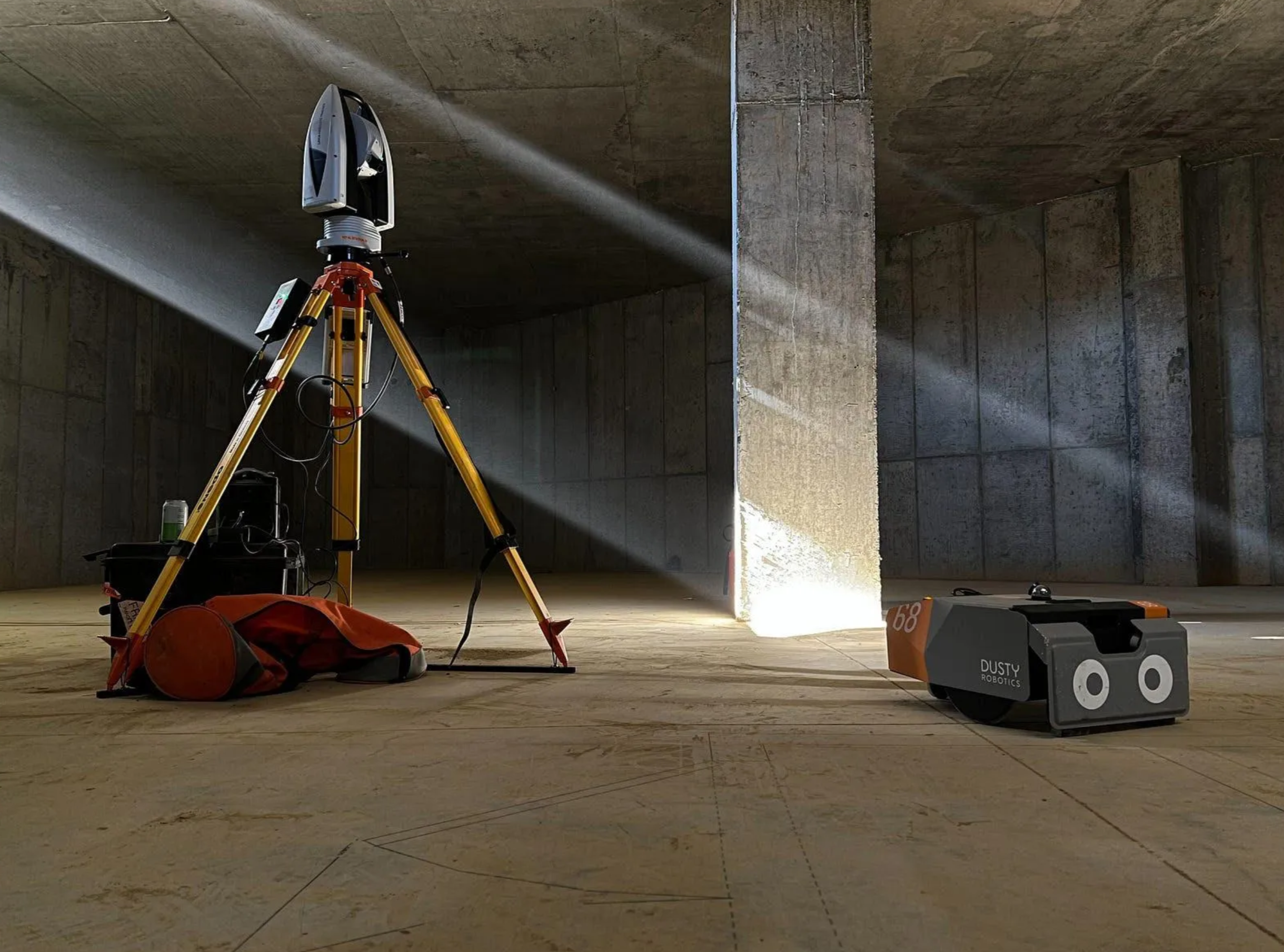
“How does the implementation of robotic layout technology contribute to enhancing cost saving and accuracy in construction projects, as exemplified by Industry expert’s experiences?”
As an individual who has worked on a robotics involved construction site, it is quite curious to know how the transformation from a manual technique to the total station and finally to using robotic layouts works. Robotic layouts have been introduced in the year 2012 by kiva systems which was later on acquired by amazon [1]. They have been implemented initially for Wearhouse categorizing. For this case study we will look at robotic layouts are used for construction purpose. We will specifically look at how Industry expert’s have used dusty robots for their construction layouts.[2]
How they are used ? What’s the potential for them ? How accurate they are ? and How does the cost factor play the key point?
Now as per the industry, there is an increasing demand for efficiency, safety, and accuracy in the construction industry[3]. Traditional construction methods often face challenges related to manual labor, human error, and safety risks. The emergence of robotic layout technology presents an opportunity to address these challenges. By exploring how Industry experts has implemented robotic layout technology, we aim to understand its potential to enhance cost savings and accuracy in construction projects, thereby motivating further exploration and adoption of this technology in the industry.
1. Literature Review :
1.1 What is a robotic layout ? :
A robotic layout is the use of robots to help draw the construction layouts required for the purpose of building the interiors. The layout includes details with respect to an overlayed plan of the mechanical, engineering and plumbing (MEP) [4] and Architectural drawings. In this case study we will go over the different commercial viabilities for dusty robotics and HP robotic layouts. The motivation for this case study stems from my personal experience of working with a total station for a robotic construction site. Using the total station was a very tedious process in terms of aligning the real and 3D world.
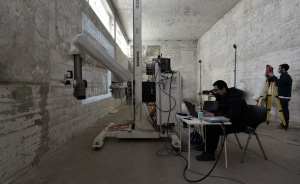
2. Purpose :
The purpose of this case study is to investigate how the implementation of robotic layout technology contributes to enhancing cost savings and accuracy in construction projects. By examining the use of robotic layout technology in construction, we aim to identify its benefits, challenges, and implications for the industry. This case study seeks to provide insights that can inform decision-making processes and facilitate the adoption of innovative technologies in construction practices.
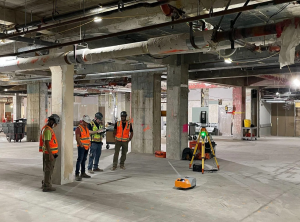
3. Methodology:
3.1 Research Design:
This case study is a qualitative research design on the introduction and utilization of robotic layout technology in the construction industry, with a specific emphasis on Industry expert’s experiences. The research is done through interviews, providing a detailed understanding of the case study process.
3.2 Detailed Description of the Facts Related to the Case:
We will explore how Skanska and Turner constructions has incorporated robotic layouts for construction, including their usage, safety considerations, potential benefits, and the role of cost savings in driving adoption. By concentrating on these key aspects, we aim to gain a comprehensive understanding of the impact of robotic layout technology on construction practices.
Skanska, a leading construction company, has embraced robotic layout technology to enhance efficiency and accuracy in its projects. These robots are equipped with advanced sensors and algorithms, allowing them to navigate construction sites, perform layout tasks, and communicate with other machinery and personnel. These robots operate autonomously or with human supervision, which is a manual mode which is operated from the control console.
Turner Constructions, stays at the forefront of innovation and plays an active role in advancing innovation in the industry. Piloting with early-stage startups gives Turner early access to bleeding-edge technologies and provides the opportunity to influence the development of solutions that can help architects, engineers, and construction managers overcome the unique challenges of the built environment[5].
3.4 Interview tool :
The interview questions very designed to gain insights into how Skanska was using robotic layouts in their construction sites.
| Number | Question |
| 1 | What were the conditions or challenges faced ? |
| 2 | What is a robotic layout according to you ? |
| 3 | How many projects have used robotic layout systems ? |
| 4 | Was there a budget set aside for innovation in robotic layout? Or was it more like there is new tech and we should totally try it? |
| 5 | Are there multiple bots used ? OR how much square footage can be covered in a certain time ? |
| 6 | How many people would you require to do traditional robot layout ? |
| 7 | Any stories about the robot able to reach a space that is otherwise unreachable for humans or that it was too dangerous ? |
These are just few among the 25 questions that were asked to collect the data.
3.5 The Data Collection:
The data collected for this case study includes:
- Interview with Skanska and Turner construction personals
- Information through studies and industry reports on the adoption of robotic technologies in construction. (Dusty Robotics and HP Robots)
4. Case Study:
4.1 Skanska
Interviewee name : Graham Condit, Director of Emerging Tech
Number of projects/ robotic layout : 5
Office Location : Seattle
Implementation process :
- Initial planning and preparation
- Selection of Dusty Robotics
- Training and deployment
Skanska often implements innovation in construction technologies including robotic layouts, to enhance efficiency and accuracy. The San Francisco team did the pilot testing with Dusty Robotics. They used Dusty robotics on a monthly services basis. Dusty robotics provided the entire service, which consisted of feeding the completed documents , which then read by the robot and is printed. The printing process happens from one room to another.
According to Graham , robotic layout is a system which can replace the traditional surveying methodologies which requires three people, with just one person to handle it. Graham describes “Robotic Layout as more like baby sitting ” compared to the physically demanding task of striking lines and marking by hand. Robotic layouts can really help with marking curves, different annotations and multiple layers of markings.
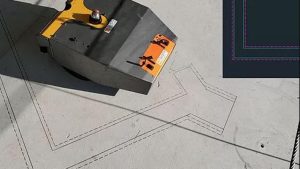
Skanska has used Dusty Robots on five projects so far. The layouts are implemented only for the interiors. Dusty Robots print from AutoCAD files, integrating seamlessly with existing design software to execute precise layout tasks.
The costing model for dusty robots is in two types: Project based lease and annual subscription mode, with a minimum term of three months at $20,000 per month. Currently, robotic layout is more expensive than the traditional method. But in the future it would become a common means. The package at the moment includes the robot, a certain amount of ink, the tablet and training a minimum of 3 days [6]. They have different types of ink including solvent-based and water-resistant types. When requested, they would also deploy numerous bot to compress the work schedule, this would be at an additional cost.
They conducted several accuracy tests alongside traditional layout methods. The robot drew lines and annotations, and the tolerances were checked. The tests showed that the robot excelled, with near perfect accuracy. The only challenge encountered was a slight tolerance issue with lines drawn close columns or walls, with differences ranging from 1/8th to a 1/4 inch depending on the situation. According to Graham there could be an improvement made in the part of adding sensors to the bot to be able to sense the uneven floor, in the sense of depressions and sleeves. Otherwise the robot prints exactly what it is fed.
From Skanska point of view it depends on project loads, if there is a need , then it would be required to deploy more bots. As they bots play a huge role in the efficiency. And when there is an increase in unskilled labor, These bots would definitely help gap the accuracy and precision required for robotic layout[7].
“Robotic layout technology significantly reduces the physical strain on our workers and enhances accuracy. Its not just about doing the job faster; its’s about doing it better and safer. The robots help us achieve precision that manual methods often miss, and this translates to fewer errors and rework, ultimately saving both time and costs.” – Graham
4.2 Turner Construction
Interviewee name : Chris McKee, Reality Capture Manager / Surveyor And Shannon Hovan, Architect / Project Manager
Number of projects/ robotic layout : 3 (Chris), 5 ( Shannon)
Office Location : Seattle
Implementation process :
- Initial Planning & Training
- Selection of HP robots
- Deployment on site
Convincing the team of using innovative technologies only boils down to how much as everyone is on board of experimenting with new technology. “On your knees, Off your knees, On your knees “ – Shannon, according to her it takes a minimum of 2 people to a maximum of 4 people depending on the project, an estimate of 3000 sqft per day.
The HP robotic layout uses AutoCAD as inputs for out putting prints. As of now most of the robotic layouts are done using just one robot. Helps to print even the smallest annotations required for site detailing. for example Chris talks about printing even the nails required to be drilled, These locations could be printed making it easier for the team to drill them in the exact spot to accuracy.
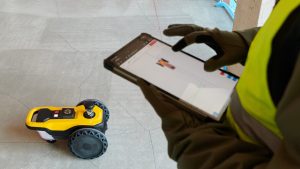
The cost of HP robot comes to an approx. of $75,000 ( X model).Depending on the material of the flooring a different type of ink is used. For example for the polished concrete floor they would use water based ink so as to remove it later on. Used the printer for all 19 floor of the liberty mutual building for the Boston SQL. Robotic layout could do 10,000 sqft per day.
They conducted several accuracy tests alongside traditional layout methods. The robot drew lines and annotations, and the tolerances were checked. The tests showed that the robot excelled, with near-perfect accuracy. The only challenge encountered was a slight tolerance issue with lines drawn close to columns or walls, with differences ranging from 1/8th to a quarter inch depending on the situation.
The HP robot is able to print all the hatch work as well as in a traditional method it would take a very long time. During one of the projects they were putting up the roof and so they had to life it out which made it hard for alignment and since they were all taped up the only option was to send the robot up there which allowed them to continue and finish work with a better accuracy. The robot leaves about 3 to 7 inches gap. Though in an ideal case it should be one inch.
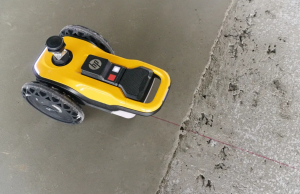
While having people around the site , its possible to loose the robot while its printing and so Turner constructions usually just print on the day there are very less worker. For one project the plans were printed as a mirrored set. being able to detect that before the print starts would help to decrease the error time to solve it. The AutoCAD file would have different layers consolidated into one, but the robot still seems to printing at random. It would print one part and move to the other side and then back. This causes worker movement on site to be a little restricted while the bot is printing. There was configuring issue that happened making the robot print excess ink and while it was moving it was sensing the excess as obstacle. Which cases it to shut down for an hour. These are points for further improvements. But as a whole the HP robots aligns with Turner construction goals.
5. Conclusion:
The implementation of robotic layout technology in construction projects significantly enhances cost savings and accuracy. Both Skanska and Turner Construction have demonstrated the potential of these technologies to improve efficiency, reduce physical strain on workers, and achieve accuracy. While initial costs are higher, the long-term benefits in terms of time savings, reduced errors, and enhanced safety make robotic layouts a valuable investment for the construction industry.
Enhancing the technology in construction will change the face of skilled labor, safety on construction sites and the cost to implementing the technology. Innovation in construction is slowly growing and different technologies are going to help in changing the term “construction is slow”[8] to ” Construction rapidly Innovating”.
6. Reference:
- https://www.therobotreport.com/a-decade-after-acquiring-kiva-amazon-unveils-its-first-amr/ ↵
- https://aecplustech.medium.com/how-dusty-robotics-is-transforming-construction-with-robotics-and-ai-9483793e2b3 ↵
- https://www.dustyrobotics.com/about ↵
- https://www.sciencedirect.com/science/article/abs/pii/S0965997816301880?casa_token=_26lfDp2WRQAAAAA:zXqAG76HagTv4bUPXMoVEm8O6warkT2hh4c2DYya2ki3pU2NzZGTwLSA_rYrNU7o74kJQJv5SA ↵
- https://www.turnerconstruction.com/uploads/Turner-Innovation-Advancing-Robotics-in-Construction-Dusty-Robotics-Pilot.pdf ↵
- https://www.dustyrobotics.com/pricing ↵
- https://view.ceros.com/skanska/innovation-with-impact/p/2 ↵
- https://www.mckinsey.com/capabilities/operations/our-insights/improving-construction-productivity ↵

